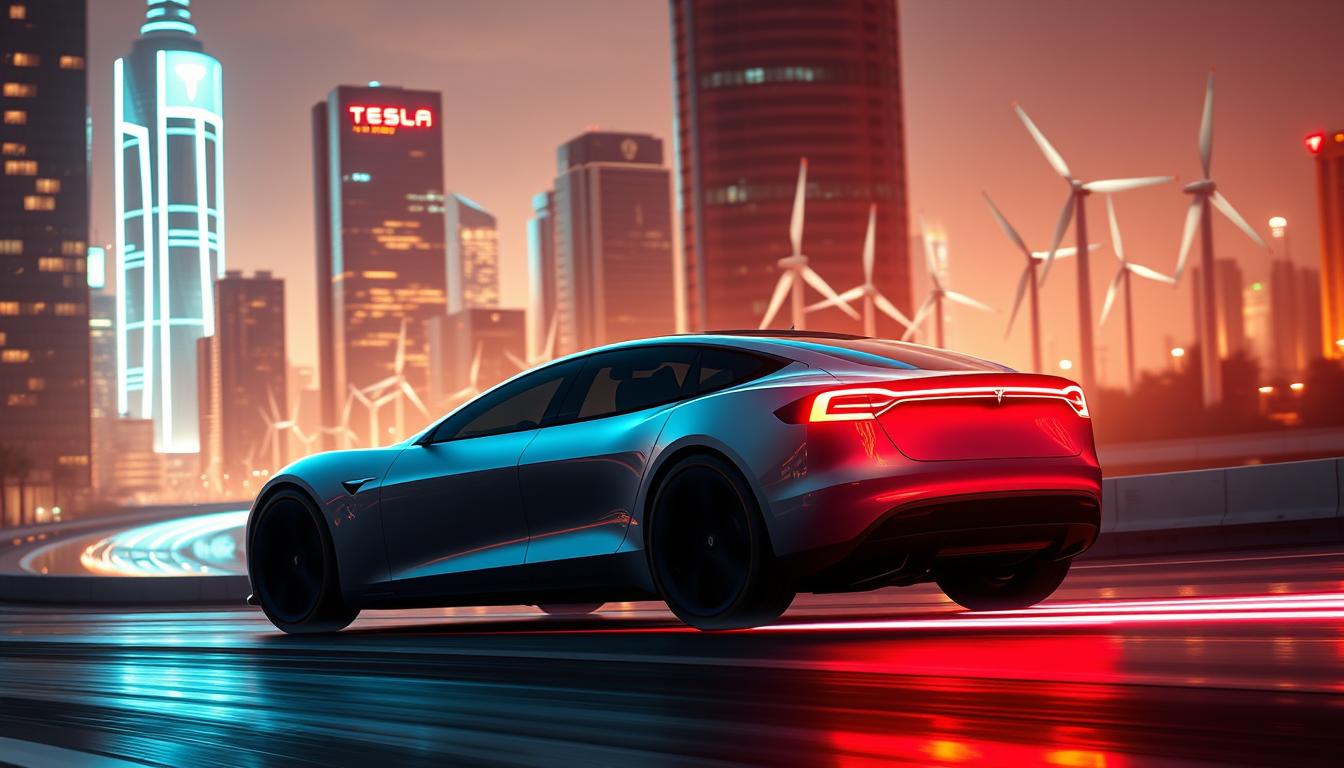Tesla has revolutionized the automotive industry with its innovative approach to electric vehicles, forcing other automakers to adapt and innovate. Founded in 2003 by a group that includes Elon Musk, Tesla has positioned itself as a leader in the industry, with a focus on business strategy and startup growth. The company’s emphasis on entrepreneurship tips and business case studies has made it a model for entrepreneurs and business leaders around the world.
With its direct-to-consumer sales model and emphasis on sustainability, Tesla has become synonymous with the electric vehicle revolution. The company’s ability to disrupt traditional business models and capture a significant share of the market has been a key factor in its success. As a result, Tesla has become a prime example of how to achieve startup growth and implement effective business strategy, providing valuable lessons in innovation for companies across various industries.
Tesla’s commitment to innovation and sustainability has resonated with consumers, contributing to the global momentum towards electric vehicles. The company’s approach to business has also provided valuable entrepreneurship tips, highlighting the importance of disruptive marketing strategies and a strong brand identity. By studying Tesla’s business case studies, companies can gain insights into how to achieve success in innovation-driven industries.
Key Takeaways
- Tesla has disrupted the auto industry with its innovative approach to electric vehicles
- The company’s emphasis on business strategy and startup growth has made it a model for entrepreneurs
- Tesla’s direct-to-consumer sales model has allowed for greater control over pricing and customer relationships
- The company’s commitment to sustainability has resonated with consumers and contributed to the global momentum towards electric vehicles
- Tesla’s approach to business has provided valuable entrepreneurship tips and business case studies for companies across various industries
- The company’s use of disruptive marketing strategies has enabled it to capture a significant share of the automotive market
The Vision Behind Electric Innovation
Tesla’s commitment to electric vehicles began with the introduction of the first electric vehicle on the road in 2008. This move was a result of innovation strategies that focused on sustainable energy and reducing carbon emissions. The company’s corporate finance strategies have played a crucial role in navigating the challenges of the auto industry and staying ahead of the competition.
With over 80% of digitally mature companies citing innovation as one of their core strengths, it’s clear that Tesla’s approach has been successful. The company’s leadership skills have been instrumental in driving this innovation, with a focus on collaboration and strategic partnerships. As the automotive industry continues to evolve, Tesla’s commitment to electric vehicles and sustainable energy will likely remain a key driver of its success.
Some key statistics that highlight the importance of innovation in the automotive industry include:
- Over 80% of digitally mature companies cite innovation as one of their core strengths.
- Sixty-five percent of fast-growing companies report collaborating with their customers on potential innovations.
- The automotive industry is heavily reliant on fossil fuel technologies, contributing significantly to global CO2 emissions.
Tesla’s vision for a sustainable energy future is driving its innovation strategies and corporate finance decisions. With its strong leadership skills and commitment to electric vehicles, the company is well-positioned to continue leading the way in the automotive industry.
| Company | Innovation Strategy | Corporate Finance |
|---|---|---|
| Tesla | Focus on sustainable energy and electric vehicles | Strategic partnerships and collaborations |
| Mercedes-Benz | Prioritizing digital product development | Investing in electric vehicle technology |
Reimagining the Traditional Business Model
As the auto industry continues to evolve, companies are looking to business success stories like Tesla to learn how to stay ahead of the curve. By analyzing market trends, it’s clear that innovation and customer experience are key to success. For example, Tesla’s introduction of electric vehicles has contributed to a projected global increase of up to 30% in electric vehicle market share by 2030.
Some key small business ideas for entrepreneurs looking to innovate and disrupt their own industries include investing in sustainable energy solutions and leveraging technology to improve customer experience. The global electric vehicle market is expected to grow at a compound annual growth rate (CAGR) of approximately 22% from 2021 to 2028, making it an attractive industry for new entrants.
Here are some key statistics that highlight the importance of innovation in the auto industry:
- Tesla’s Model 3 achieved over 500,000 units sold in its first year alone, setting a record for the fastest-selling electric car in history.
- The company’s Supercharger network has expanded to over 30,000 chargers worldwide, reducing range anxiety for EV users and supporting a growing ecosystem.
- Research indicates that consumers may be willing to pay approximately 20% more for EVs that showcase superior performance and sustainability.

By reimagining the traditional business model and focusing on innovation and customer experience, companies like Tesla are able to stay ahead of the competition and achieve business success. As the industry continues to evolve, it will be interesting to see how other companies adapt to changing market trends and incorporate small business ideas into their strategies.
| Company | Market Share | Growth Rate |
|---|---|---|
| Tesla | 18% | 22% |
Direct-to-Consumer Sales: Disrupting Dealer Networks
Tesla’s direct-to-consumer sales model has been a key factor in the company’s success, allowing it to disrupt the traditional dealer network and build a loyal customer base. By cutting out the middleman, Tesla has been able to reduce costs and increase efficiency, making its products more competitive in the market. This approach is a great example of innovation strategies that can be applied to various industries.
Some notable companies that have successfully implemented direct-to-consumer sales models include Casper, Harry’s, and Glossier. These companies have achieved significant growth and customer loyalty by leveraging entrepreneurship tips such as social media marketing, influencer partnerships, and personalized customer experiences. For instance, Casper has achieved $100 million in sales in just under 2 years after launching in 2014, while Glossier’s blog-first strategy attracted 1.5 million potential customers at launch.
Here are some key statistics that highlight the success of direct-to-consumer sales models:
- 22 direct-to-consumer companies analyzed have achieved significant growth and revenue
- Casper achieved $100 million in sales in just under 2 years after launching in 2014
- Glossier’s blog-first strategy attracted 1.5 million potential customers at launch
By studying business case studies of successful direct-to-consumer companies, entrepreneurs and businesses can gain valuable insights into the strategies and tactics that have driven their success. This can help them develop their own innovative approaches to sales and marketing, and stay ahead of the competition in today’s fast-paced business landscape.
Business Strategy and Startup Growth: The Tesla Blueprint
Tesla’s success can be attributed to its well-executed business strategy, which has enabled the company to achieve remarkable startup growth. By focusing on innovation, customer experience, and sustainable energy, Tesla has become a leader in the auto industry. Other companies can learn from Tesla’s approach by incorporating entrepreneurship tips such as niche targeting, effective go-to-market strategies, and robust capital resources.
Some key factors that have contributed to Tesla’s success include:
- Proven monetization approach
- Effective go-to-market strategies
- Robust capital resources
- Ambidextrous organizational structure
These factors have enabled Tesla to navigate the extrapolation stage effectively, transitioning from achieving product-market fit to profit-market fit.

Tesla’s market capitalization surpassed $800 billion in 2021, making it the most valuable automotive company globally. The company’s revenue reached $81.5 billion in 2022, marking a significant growth from $31.5 billion in 2020. By incorporating business strategy and entrepreneurship tips, other companies can achieve similar startup growth and success.
Tesla’s success is a testament to the importance of innovation, customer experience, and sustainable energy in achieving remarkable growth and profitability.
Technology as a Competitive Advantage
Tesla’s innovative approach to technology has been a key factor in its success. By leveraging software integration and over-the-air updates, the company has been able to stay ahead of the competition. This focus on innovation strategies has allowed Tesla to create a competitive advantage in the market.
Some notable statistics that highlight the importance of innovation include:
- 63% of companies implementing innovation management reported sustained competitive advantages in their respective markets.
- 54% of businesses noted an increased rate of innovation cycle speed when integrating startup collaboration programs.
- Companies utilizing intrapreneurship programs saw a 20% increase in employee creativity and idea generation.
Additionally, Tesla’s leadership skills and corporate finance strategies have played a crucial role in its ability to invest in research and development, driving innovation and growth. The company’s commitment to innovation has enabled it to stay ahead of the curve and maintain its position as a leader in the industry.
| Company | Innovation Strategy | Result |
|---|---|---|
| Tesla | Software integration and over-the-air updates | Competitive advantage in the market |
| Zoom | Video conferencing platform | 300 million daily participants |
| SpaceX | Rocket reusability | Leader in aerospace, $6 billion in private investment |
Marketing Mastery: Building a Movement, Not Just a Brand
Tesla’s success can be attributed to its ability to build a movement around its brand, rather than just selling cars. By focusing on business success stories and staying ahead of market trends, Tesla has created a loyal customer base. This approach can be applied to small business ideas, where entrepreneurs can focus on creating a community around their brand, rather than just selling products.
Companies like Moz and Shopify have successfully built a movement around their brands by providing valuable content and resources to their customers. For example, Moz’s “Whiteboard Friday” series has established it as a trusted resource in SEO, contributing to a significant growth in web traffic. Similarly, Shopify’s blog has garnered over 27 million page views, reflecting the success of its content strategy in attracting and retaining an audience.
By focusing on customer experience and innovation, businesses can create a marketing strategy that is both successful and sustainable. This can be achieved by providing valuable content, engaging with customers, and staying ahead of market trends. As seen in various business success stories, building a movement around a brand requires a deep understanding of market trends and a willingness to adapt to changing customer needs, making it an essential aspect of small business ideas.
| Company | Marketing Strategy | Result |
|---|---|---|
| Moz | Valuable content and resources | Significant growth in web traffic |
| Shopify | Content marketing and customer engagement | Over 27 million page views on its blog |
| Tesla | Building a movement around its brand | Loyal customer base and significant sales growth |
Financial Innovation and Capital Raising
Tesla’s success can be attributed to its ability to navigate the complex world of corporate finance. The company has used innovative strategies to raise capital, including unconventional funding approaches. This has allowed Tesla to stay ahead of the competition and achieve its goals. With strong leadership skills and a focus on innovation strategies, Tesla has been able to balance growth with profitability.
Some of the key factors that have contributed to Tesla’s success in financial innovation and capital raising include:
- Ability to adapt to changing market conditions
- Strong relationships with investors and stakeholders
- Focus on innovation strategies that drive growth and profitability
Tesla’s approach to financial innovation and capital raising has been studied by many in the industry. The company’s use of corporate finance strategies has allowed it to raise significanticare capital and invest in new technologies. With its strong leadership skills and focus on innovation strategies, Tesla continues to be a leader in the automotive industry.
The following table summarizes some of the key statistics related to financial innovation and capital raising:
| Category | Statistic |
|---|---|
| Total amount raised through equity crowdfunding | 171 million baht |
| Number of successful ECF projects launched | 12 |
Leadership Lessons from Elon Musk’s Playbook
Elon Musk’s leadership style has been a key factor in Tesla’s success, and other companies can learn from his approach. With a focus on innovation strategies, Musk has been able to drive growth and scalability in his companies. His leadership skills have also been instrumental in building a strong brand and customer loyalty.
Some of the key entrepreneurship tips that can be learned from Musk’s playbook include his ability to think outside the box and take risks. He has also been able to build a strong team and empower them to make decisions. Additionally, Musk’s focus on innovation strategies has allowed him to stay ahead of the competition and drive growth in his companies.

- Tesla’s market capitalization consistently ranged between $700 billion to $1 trillion by 2023
- Tesla delivered over 3 million electric vehicles globally by the end of 2023
- SpaceX launched over 200 missions with its Falcon 9 rocket by 2023
These statistics demonstrate the impact of Musk’sleadership skillsandinnovation strategieson his companies’ success.
Elon Musk’s leadership style is a unique blend of transformational leadership and micromanagement, which has been shown to increase employee engagement and performance.
Overall, Musk’s playbook offers valuable lessons for companies looking to drive growth and innovation. By focusing on leadership skills, innovation strategies, and entrepreneurship tips, companies can build a strong brand and achieve success in their respective industries.
Conclusion: The Future of Automotive Innovation and Industry Transformation
As we have seen, Tesla’s innovative approach has undoubtedly disrupted the automotive industry, serving as a powerful case study for business strategy, startup growth, entrepreneurship tips. By reimagining the traditional business model, leveraging technology as a competitive advantage, and mastering the art of marketing, Tesla has paved the way for a new era of sustainable mobility.
The future of the automotive industry is poised for even greater transformation, with advancements in electric vehicles, autonomous driving, and shared mobility solutions. Business case studies like Tesla’s demonstrate the immense potential for startups and established players alike to drive innovation and reshape the landscape. By embracing disruptive technologies, fostering customer-centric strategies, and prioritizing environmental sustainability, the automotive sector can continue to evolve and better serve the needs of a rapidly changing global market.
As the industry navigates these exciting times, the lessons learned from Tesla’s success will undoubtedly inspire and guide the next generation of automotive innovators. By following their lead and adapting to the shifting demands of consumers and the ever-evolving regulatory landscape, the future of the automotive industry promises to be both transformative and sustainable.
FAQ
How has Tesla disrupted the auto industry?
Tesla has disrupted the auto industry with its innovative electric vehicle technology, focus on sustainable energy, and unique business model. The company’s approach has forced other automakers to adapt and innovate in order to stay competitive.
What is the vision behind Tesla’s electric innovation?
Tesla’s vision is to accelerate the world’s transition to sustainable energy through its electric vehicles and other innovative products. The company has faced early challenges but made strategic decisions to achieve its goals and build a brand that goes beyond just cars.
How has Tesla reimagined the traditional business model of the auto industry?
Tesla has disrupted the traditional dealer network by using a direct-to-consumer sales model, which has led to legal battles but also allowed the company to build customer loyalty through direct engagement. This approach has also helped Tesla cut out the middleman and improve the economics of its business.
What are the key factors behind Tesla’s business strategy and startup growth?
Tesla’s success can be attributed to its focus on innovation, customer experience, and sustainable energy. The company has been able to create a new business model that is both successful and sustainable, serving as a model for other companies to follow.
How has Tesla’s technology been a competitive advantage?
Tesla’s technology, including its software integration, over-the-air updates, battery innovation, and autonomous driving development, has been a key competitive advantage that has allowed the company to stay ahead of the competition.
How has Tesla built a movement around its brand?
Tesla has successfully built a movement around its brand by focusing on customer experience and innovation. The company’s marketing strategy has been a key factor in its success, and other businesses can learn from Tesla’s approach to building a loyal customer base.
How has Tesla used financial innovation and capital raising to achieve its goals?
Tesla has employed unconventional funding approaches, including stock market strategy and investor relations, to finance its growth and navigate the challenges of balancing growth with profitability. The company’s corporate finance and leadership skills have been crucial to its success.
What leadership lessons can be learned from Elon Musk’s playbook?
Elon Musk’s leadership, characterized by his focus on innovation, customer experience, and sustainable energy, has been a key driver of Tesla’s success. Other companies can learn from Musk’s approach to leadership and innovation strategy.
